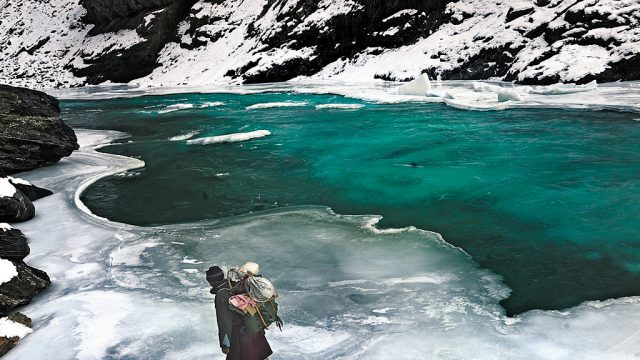Snowed under for seven months a year, when its denizens can reach the outside world only by walking on the frozen Zanskar river, the remote Zanskar Valley is perhaps one of the last Shangri Las. It is a large area of about 5,000 sq km made up of two valleys, the Stod or Doda and the Tsarap or Lugnak, which meet to form the Zanskar river at Padum, which in turn meets the Indus at Nimmu, west of Leh. A road of sorts was built in the late 1970s connecting Padum in this once ‘Hidden Himalayan Kingdom’ to Kargil. But even this road is cut off during the seven months of severe winter.
The 250-km journey from Kargil to Padum, though physically punishing, amply compensates through the stunning beauty of the Suru Valley. And despite Padum being Zanskar’s largest settlement, administrative centre and trekking-launch point, it still remains a place where people wait for hours, gossiping and at ease, for a bus to pass by.

Padum
A scattering of small, whitewashed buildings in a vast plain with a tiny population of about 1,500 – this is Padum. It is also a hub for the legendary treks in Zanskar – south-east into Darcha in Himachal; south-west over the Omasi La pass into Kishtwar; north over the Zanskar Range to the Sham region, or Hemis monastery. Packhorses, guides and supplies can all be procured here.
Zanskar’s Gompas
The vast plains beyond Padum are where most of the population of Zanskar resides as it is a relatively good farming and grazing area. Thus, some of the most important and beautiful monasteries have been constructed here. The high peaks of the Zanskar Range form a scenic backdrop to the pastoral beauty of these plains.
Pibiting Monastery
North of Padum back towards Karsha, in a lovely village beside the Tsarap, lies this monastery, offering expansive views of the valley. A litte ahead is the Dalai Lama’s Zanskar residence, the Photang, a square two-storeyed structure.
Sani Gompa
A rare gompa built not on a hill slope but on the ground, Sani may be the oldest monastery in Zanskar. Of particular interest is the ancient Kanika Stupa behind the gompa, associated with Emperor Kanishka (1st century CE). In a small shrine near this stupa, you can see old icons and murals.
Zangla Fort
Just 31 km northeast of Padum, Zangla was once the ancient capital of Zanskar, and the ruins of its fort can be seen high on a hill above the village. The fort is a square three-storeyed structure, with narrow balconies that look out from the top floors. This was where half of Zanskar was once ruled from. It was also where Alexander Csoma de Korös, the 19th-century Hungarian Tibetologist, stayed and worked for a year in 1823. A narrow passageway leads into the fort. Many rooms have fallen, but it is still possible to climb up to Csoma’s small dark room on the third floor. Do stop by and meet the friendly nuns at the Zangla nunnery nearby.

Bardan Gompa
The 17th-century Bardan Gompa, 11 km southeast of Padum, is located on a sheer hilltop rising above the Tsarap river. On an average day, hardly any monks are to be seen, and the fading but beautiful murals recreate the centuries gone by effectively. It is especially worth a visit for its huge prayer wheel.
Phugtal Gompa

Nestled under a yawning cavern, fitting so snugly into crevices and footholds that it seems to grow out of the mountain, the Phugtal Gompa is an amazing piece of architecture. The Buddhist monastery – built on a foundation of twigs and mud – has survived the ravages of the Zanskar landscape, since the 12th century, when it was founded by Gangsem Sherap Sampo. Overlooking a gorge through which flows a tributary of the Lugnak river, this Gelugpa retreat harbours 70 monks, prayer rooms and a library. Phugtal was first built in a cave on the cliff and the later additions were almost beehive-like accretions. The gompa has some exquisite murals similar to those at Alchi. Phugtal is 70 km south-east of Padum, but cannot be reached by road; the best way to visit is by a trek organised with Himalayan Homestays (Leh office: Tel: 01982-252074, 252355; Padum office: Cell: 09419657213, 094198- 15906; ladakh-tours.com)
WHERE TO STAY AND EAT
In Padum
The most luxurious of the lot is Marq Hotel (Tel: 01983-245071, 245223, Cell: 09418002171; Tariff: ₹4,900), which has running hot water and plush rooms. Also among the better options are Hotel Omasila (Tel: 245075, Cell: 09469369100; Tariff: ₹2,400-2,800) in Pibiting, Zambala Hotel (Cell: 09906990623, 09419242838; Tariff: ₹3,800); and Hotel Ibex (Tel: 245012, Cell: 09469545962; Tariff: ₹1,800, with meals). The latter is popular with trekkers and has rooms located around a sunny central courtyard. Mont Blanc Guest House (Cell: 09419177627; Tariff: ₹700) is smaller and cheaper. The J&K Tourism Bungalow (Tel: 245017; Tariff: ₹400- 500) has 15 rooms.

Elsewhere in Zanskar
The Snow Leopard Conservancy’s Himalayan Homestays programme organises accommodation in several villages in Zanskar – at Karsha, Zangla, Pidmo, Pishu, Anmu, Ichar, Cha, Reru and Dorzang. These can be booked at Himalayan Homestays (Cell: 09419657213) in Leh and Padum, or through Leh-based operators. Himalayan Homestays aims to provide villagers alternative sources of income, in the hope that this will bring down the retaliatory killing of snow leopards, a predator of livestock. In Karsha, for instance, stay is in the home of a person called Mutup Chospel. Simple and clean guestrooms on the third floor of Chospel’s house offer stunning views of the mountains. Tariff is ₹800 per person, per night, including breakfast, tea, lunch and dinner.
When to go June to September is when the high passes are free of snow, and it is possible to drive from Kargil to Zanskar Location The Zanskar Valley lies between the Great Himalayan and Zanskar ranges, south-west of Leh and southeast of Kargil, in Kargil District Air Nearest rail: Leh Rail Nearest rail: Jammu




